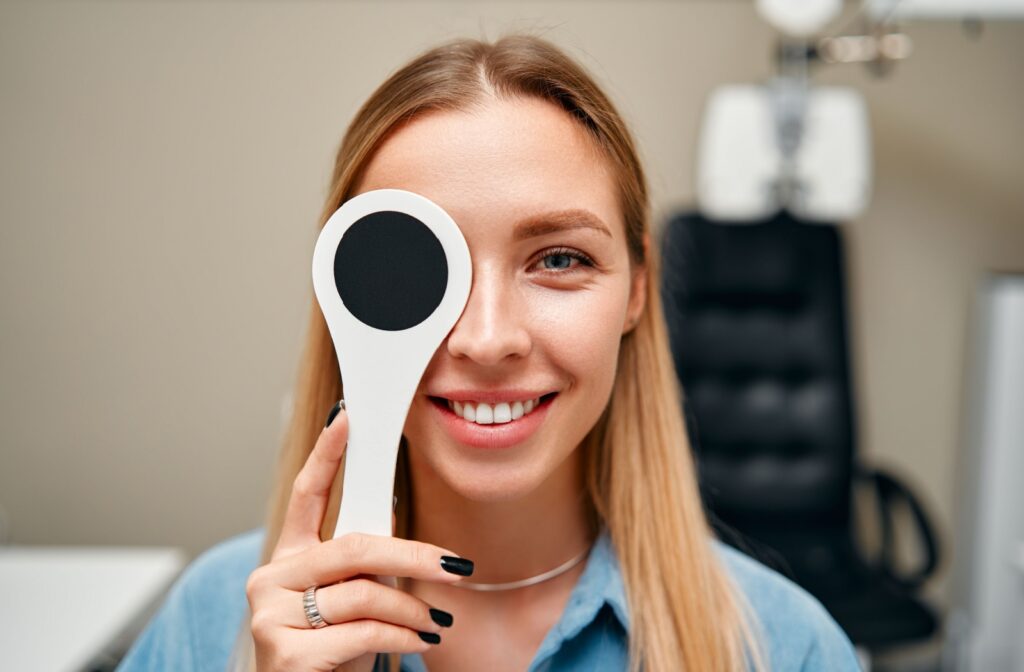Many people believe that lazy eye only affects children, but this common misconception can prevent adults from seeking the treatment they need. Several things can cause there to be a lazy eye in adults, including untreated childhood strabismus, untreated childhood prescription imbalances and even acute circulatory/neurological events.
What Is Lazy Eye?
Lazy eye, or amblyopia, occurs when one eye fails to develop normal vision during childhood. The term “lazy” can be misleading. The eye isn’t actually lazy. Instead, the brain favours one eye over the other, leading to reduced vision in the weaker eye.
While amblyopia typically begins in early childhood, it can persist into adulthood even with treatment. Treatment in childhood may reduce or eliminate amblyopia if diagnosed and treated early.
What Causes Lazy Eye?
While amblyopia is a developmental condition that occurs when the brain is still forming, some people may not discover they have it until adulthood. The most common causes of amblyopia are refractive errors and strabismus.
Refractive Errors
Significant differences in prescription between the two eyes, known as anisometropia, can cause amblyopia. When one eye has substantially different vision requirements than the other, this causes the brain to favor the eye with clearer vision and not build sufficient neurological connections.
Strabismus
Strabismus, or misaligned eyes, is another cause of amblyopia. When the eyes don’t align properly, the brain receives conflicting visual information. To avoid double vision, the brain suppresses input from the misaligned eye, which can lead to amblyopia. Strabismus typically develops and is diagnosed in children. But strokes or tumours could cause an adult to develop strabismus as well.

How Is Lazy Eye Diagnosed?
Diagnosing amblyopia in adults requires a comprehensive eye examination performed by a qualified optometrist. Several diagnostic methods may be used:
Visual Acuity Test
The visual acuity test measures how well each eye sees. This helps identify differences in vision between the eyes and determines the severity of vision reduction in the affected eye.
Alignment Evaluation
An alignment evaluation checks how well your eyes work together and whether they’re properly aligned. This assessment may include:
- Cover testing to detect eye misalignment
- Evaluation of eye movement and coordination
- Assessment of binocular vision function
- Testing for suppression of one eye
- Testing stereo depth perception
Eye Health Assessment
A comprehensive eye health assessment examines the internal and external structures of your eyes. This evaluation includes:
- Examination of the retina and optic nerve
- Assessment of eye pressure
- Evaluation of the lens and cornea
- Checking for signs of eye disease or injury
Treatment Options for Adult Lazy Eye
Treatment approaches vary based on the underlying cause and severity of the condition. Common approaches include:
Vision Therapy
Vision therapy involves structured exercises designed to improve visual skills and strengthen the connection between the eyes and brain.
Vision therapy exercises may include:
- Eye movement exercises
- Focusing activities
- Coordination training
- Perceptual learning tasks
Research suggests that vision therapy can improve visual acuity and binocular function in people with amblyopia.
Corrective Lenses
Properly prescribed corrective lenses can help address refractive errors that contribute to amblyopia. Special types of lenses may be recommended, including:
- Glasses with different prescriptions for each eye
- Contact lenses for better visual correction
- Prism lenses to help with eye alignment
- Specialized filters or coatings to enhance vision
Eye Patching
While traditionally associated with childhood treatment, eye patching can still be beneficial for some adults depending on their ocular condition.
Surgery
In cases where structural problems cause lazy eye, surgical intervention may be necessary. Surgery may also be considered when other treatment methods haven’t provided sufficient improvement. Surgical treatment may include:
- Strabismus surgery to correct eye alignment
- Cataract removal to clear vision obstruction
- Corneal procedures to address scarring or irregularities
Discuss Your Concerns with Us Today
If you suspect you might have amblyopia or are experiencing vision difficulties, contact our team at Northern Lights Optometry today to book your appointment and take the first step toward clearer, more comfortable vision.





